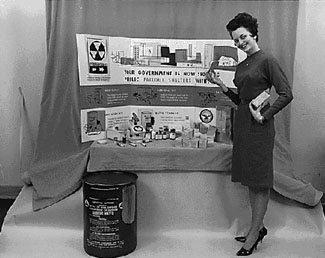The Corps Helped Answer President Kennedy's Call for National Preparedness
"We are not against any man—or any nation—or any system—except as it is hostile to freedom." So stated President John F. Kennedy on 25 May 1961 in response to crises in Berlin and Cuba. The occasion was a special address to Congress on Urgent National Needs.
In the address President Kennedy spoke at length on civil defense, which he characterized as "insurance for the civilian population in case of an enemy miscalculation." To overcome years of neglect, he assigned responsibility for civil defense to the Secretary of Defense and established a National Fallout Shelter Program.
The Secretary of Defense created an Office of Civil Defense within the Department and tapped the Corps of Engineers and the Navy’s Bureau of Yards and Docks to conduct a fallout shelter survey and other civil defense tasks. The initial mission was to identify structures, determine their ability to reduce the dosage of radiation resulting from a nuclear attack by a factor of 20, and mark them as public shelters. The goal was to find shelter for up to 50 million Americans.
 |
| Fallout shelters were stocked with federally procured water, food, and medical and sanitation supplies, as well as radiation monitoring kits, 1961. |
The Corps responded by creating a Joint Civil Defense Support Group in the Chief’s office with a colonel in charge. The Corps staffed the new headquarters organization and similar offices with division and district personnel. As was customary, most of these personnel were diverted from civil works assignments.
Within a short time, the National Fallout Shelter Survey achieved impressive results. The Corps developed specialized techniques for computer processing of survey data; developed scientific methods to evaluate potential shelters; trained nearly 1,500 architect-engineers and Corps employees; and negotiated and supervised more than 500 A-E contracts to conduct the nationwide survey.
Additional tasks included preparing the following: engineering and cost studies of standard structures for emergency operating headquarters; pilot feasibility studies to determine local capabilities to quickly increase the number of public shelters; technical civil defense publications; a nationwide survey of construction and engineering equipment and inventory of potential contractors; and a survey of fallout shelters for selected radio and television stations in the National Emergency Broadcast Network.
The program continued throughout the 1960s and by 1970 was consolidated at the division level. Overall management passed to the Defense Civil Preparedness Agency in 1972. This organization was subsumed into the Federal Emergency Management Agency (FEMA) in 1979.
The Corps’ response was another example of the agency’s agility at adjusting from within to changing missions and utilizing a decentralized organization and established contracting expertise to fulfill a critical national security need.
* * *
October 2001